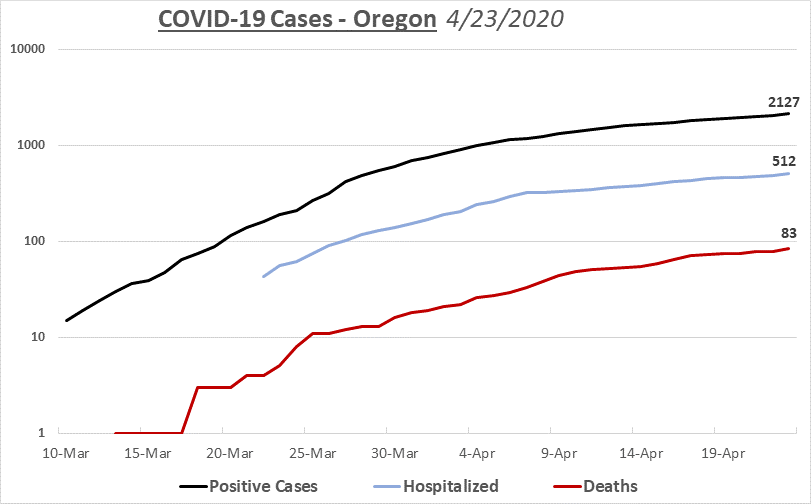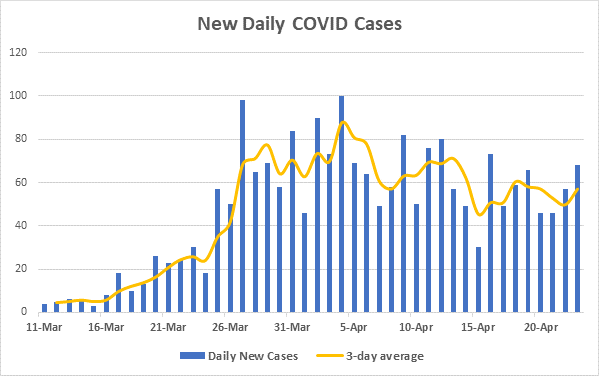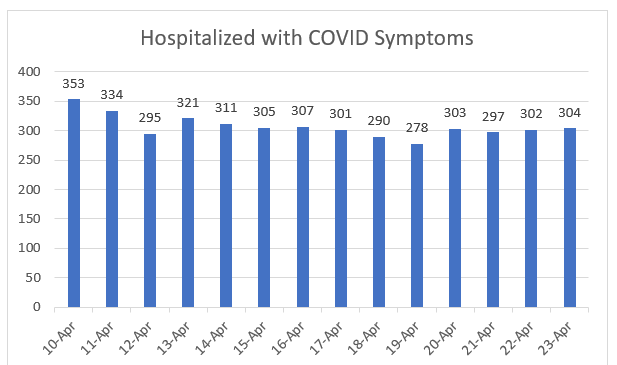|
April 23, 2020
Dear Neighbors and Friends:
I hope that you and your loved ones are doing well, staying healthy, and looking out for your neighbors and friends.
The Emergency Board did meet today and passed all of the proposed budget items except one. More on that below.
I mentioned the other day that the Governor was likely to lift the order prohibiting non-emergency medical procedures ahead of the rest of the 3-phase reopening plan. In fact, she did so today. The new order will go into effect on May 1. You can read about that below as well. We need to remain cautious and careful as we take this step, but I’ll be honest: it’s an exciting step in the road to recovery.
TODAY’S CORONAVIRUS AND CORONAVIRUS RESPONSE UPDATE

***Please notice that I’m now using an exponential scale for the Y axis on this graph. Doing it this way allows for a more realistic sense of the upward curves of these three data points (positive cases, hospitalizations, and deaths).
-
Positive Cases: OHA has reported that 68 additional Oregonians tested positive for COVID-19 yesterday, putting the total at 2,127.
-
Total Tests: The problem with this metric has been completed. The total number of tests in Oregon now stands at 43,976. That’s a 2-day increase of 2,848 tests.
-
Ratio: The percentage of positive results still remains just under 5%. That’s much lower than the national average (coming down a bit, but still just over 18%).
-
Deaths: I’m afraid I have to report that the number of new deaths has jumped back up to five, so the total number of deaths in Oregon is now 83.
-
Hospitalized: The number of Oregonians who have been hospitalized with symptoms, and who have also tested positive for the disease, is now at 512. This is an increase of 24 from yesterday.
-
Other Hospital Information:
- Available ICU Beds: 359 (an increase of 23 from yesterday)
- Other Available Beds: 2,208 (an increase of 13 from yesterday)
- Patients Currently w COVID-19 Symptoms (who may or may not have received a positive test result yet): 304 (an increase of 2 from yesterday). Of those, 131 have already received a positive test back.
- ICU Patients w COVID-19 Symptoms (who may or may not have received a positive test result yet): 74 (7 more than yesterday)
- COVID-19 Patients Currently on Ventilators: 36 (one more than yesterday).
- Available Ventilators: 803 (12 more than yesterday)
-
Today’s National Numbers:
-
PPE:
- The Emergency Coordination Center received 236,000 surgical masks, 10,000 face shields, and 1,100 gowns in the last 24 hours.
-
Other State Updates:
- The other day I reported on the Governor’s “Reopening Oregon Framework” presentation to legislators. For more clarity about it, here is the PowerPoint presentation on the framework for you.
- The OHA announced that as long as supply chains hold, we should have the capacity to do 3,000 COVID-19 tests a day very soon.
Additional Graphs:
Here are new positive tests and hospitalization updates again. You’ll see there are now three. I’m adding an additional look at the positive test data, with a line showing 3-day average of the daily cases to help make the trends a little clearer.
Special thanks to Tom Powers from the Senate Majority Office for his diligent work on these visuals.



*** Remember that the hospitalization numbers being used here are those currently in the hospital with symptoms, but who may or may not have received a positive test result yet.
Legislature’s Emergency Board Allocates $32 Million
The E-Board met this morning for three and a half hours to approve requests coming from the Governor and from legislative leadership. Speaker Tina Kotek chaired today’s meeting. Here is what they approved:
- $12 million to Housing and Community Services Department – Safe Shelter and Rental Assistance
- $5 million (added to $5 million in existing funds for a total of $10 million) to Oregon Business Development Department – COVID-19 Emergency Business Assistance
- $2 million to Department of Justice – Emergency Housing for Victims of Domestic and Sexual Violence
- $10 million to Department of Administrative Services – Oregon Worker Relief Fund
- $119,778 to Bureau of Labor and Industries – Human Resource Position
- $3.35 million to Department of Human Services – Long Term Care Worker COVID-19 Testing and Training
- $300 million to Department of Administrative Services – Authorization to spend from Federal Coronavirus Relief Fund
- $6 million to Department of Forestry – 2019 and 2020 Fire Seasons Costs (plus authorization to spend an additional $23,587,897 in outstanding expenses from last fire season).
- $20 million to Department of Human Services and Oregon Health Authority – Non-State Employee Collective Bargaining
- $3,875,965 to Public Defense Services Commission – Public Defense System Improvements
The first six items on the list are all expenditures coming out of the state’s general fund. They amount to around $32 million. The remaining four items are approvals for agencies to spend money coming from the federal government or other funds.
You’ll see that one item from their agenda is missing. It was a proposal to use $50 million of the state’s share of the federal CARES Act funding as a loan program to rural hospitals. The committee was in disagreement around whether this should be a zero-interest loan (as proposed), or a forgivable loan, or a grant, or a combination of grants and loans. In the end, they decided to table the motion for today and come back to it in a future meeting, perhaps next week or sometime soon. The advantage is that by then we’ll have a better sense of the additional direct federal funding going to hospitals in the new federal bill that was just passed today.
You can get all the details about each of these allocations by going to the meeting materials page. Each of the items on the list is explained by a separate document, identified by its list number.
We learned that Oregon has already received $870 million of the $1.6 billion in CARES Act money coming to the state. There’s still not complete clarity around how that money can be spent. Some of that $1.6 billion (likely $200-300 million) will need to go to large local jurisdictions, i.e., jurisdictions with more than 500,000 residents. The three jurisdictions that fit that model in Oregon are Portland, Multnomah County, and Washington County. At this point, by the way, it appears that these dollars can ONLY be used for new COVID-response activities, not to reimburse us for actions we took prior to March 27, nor to make up for lost revenues. We are still hoping that the next CARES package (“CARES 4.0”) will include money to help states and local governments survive the budget catastrophe that is ahead of us.
I will say that it was nice to see an overall tenor of bipartisanship in the meeting. There were definitely some partisan “no” votes, especially on the measure providing support for undocumented workers shut out of federal aid, but I’m happy to say that even that vote included some Republican support.
If you’d like to watch the archived meeting, you can do that here.
Governor Announces Resumption of Non-Emergency Medical Procedures
Governor Brown announced this morning that her medical advisors are recommending that medical providers be allowed to resume non-urgent, elective procedures. Although the specific requirements for resumption won’t be finalized till the middle of next week, the lifting of the prior order is scheduled to begin on May 1.
This is a step that has been broadly desired and anticipated, particularly by hospitals (especially rural hospitals) and by medical providers, including dentists, who have effectively been out of work and by patients who have been forced to put off medical and dental procedures that have been forced to put off procedures that would relieve pain and help them prevent future problems. The ability to take this step is an important step in recognizing that the Stay Home program has been successful in preventing a surge in emergency cases. It also reflects optimism that we will have the necessary amount of Personal Protective Equipment to do medical procedures safely.
It also reflects a sense that medical professionals are specially trained to guarantee proper hygiene and respect for protocols.
Legislators received further clarification on her decision this afternoon. In order to resume elective procedures, providers will need to do the following:
- Make sure their workers have enough Personal Protective Equipment (i.e., masks, gowns, gloves, face shields where needed) to do their work.
- Make sure they do their scheduling in a way that allows for separation of patients, more time for thorough cleansing, and other strategies to maintain distancing in the near term.
- Have a plan in place to pull back if it turns out that the number of infections begins to rise again.
- Hospitals will still need to reserve at least 20% of their beds for a potential increase in infections.
Workers who feel that this resumption is not happening in a safe way (e.g., inadequate PPE and distancing) will be encouraged to contact Oregon OSHA, which they can of course do anonymously.
To the extent possible, providers are also being encouraged to continue to provide care via telehealth, i.e. through video and online means. The temporary rules guaranteeing access to (and equitable insurance reimbursement for) telemedicine will continue, at least for now. Until we are well into the reopening process, it’s going to be crucial to minimize face-to-face contact and crowded waiting rooms as much as possible.
By the way, this change does not yet apply to veterinarians. We were told today that an order allowing veterinarians to resume normal (well, sort of normal) operations will come very, very soon.
As we tiptoe into this reopening, the effects on our infection rates will be closely monitored. (The Governor used the analogy of an ice skater gingerly testing the ice on a pond or river, looking for cracks, prepared to step back closer to shore if cracks appear.) Another key element will be having the necessary PPE to handle both the procedures and a potential return of increasing infections.
Many of the hospital systems are having success in obtaining PPE on their own, and they feel that they will have what they need to resume operations. Many dentists (and veterinarians) stepped up and donated their PPE to the state stockpile, which has been incredibly helpful. Legislators were told that the Emergency Coordination Center will help them get the gear that they need to return to service.
I’ll let you know when we hear more details about the May 1 medical reopening.
From the Employment Department
We received word from the Employment Department that they are at last able to start setting up the Pandemic Unemployment Program, the extension of UI benefits to the self-employed, independent contractors, “Gig” workers. They are doing some test runs with a few of them and believe that they will be able to begin processing claims by the end of the month. I know that many of you are waiting desperately for the ability to begin this process. The good news is that it is coming and the Governor just yesterday reiterated her promise that all payments owed will be paid retroactively. Everyone should be prepared for another big spike of new application numbers next week when the doors are opened for this new category of claimants.
Again, I would ask you to limit your attempts to reach the department by phone—that just clogs up the lines. Use the email: OED_COVID19_Info@oregon.gov
Here is a press release that just went out from the Department. And below is a communication that we received from them this morning:
The Employment Department received 36,700 initial claims for unemployment benefits during the week of April 12 to April 18. A total of 333,700 initial claims have been filed since widespread public health measures took effect during the week of March 15 to March 22.
We are actively working to get the Pandemic Unemployment Assistance (PUA) program running. Programming, testing, and staff training for the PUA program are in progress. Once open, the PUA program will provide the self-employed, contract workers, and gig workers not already eligible, along with those not usually eligible due to too few hours or earnings, and those who were going to start work but could not, with benefits never before available. Programming, testing, and staff training for the PUA program are in progress. Upon successful testing, the Employment Department expects to open the program for applications by the end of April. A new set of frequently asked questions for PUA and additional updates are available at the agency’s COVID-19 page.
We continue adding capacity to process claims, and getting even more benefits to Oregonians. As of this week, the Employment Department now has 520 employees now dedicated to taking unemployment claims, and additional contact center facility planning underway. During the week of April 12 to April 18, the agency paid a total of $119 million in benefits.
Hungry for More Science?
This is a time when we need good science more than ever. And the most highly respected venue for science and proper application of the scientific method in this country is our National Academy of Science. Well, the NAS is having its annual meeting this weekend. Going with the times, it will be a virtual meeting, and the Academy has decided to open its panels up to the general public. This is a great opportunity. You can get to it here.
One event of special interest right now will be on Saturday morning, starting at 11 a.m. Pacific Time and lasting 90 minutes. It is a forum on late breaking intelligent information on the pandemic virus:

2:00 p.m. to 3:30 p.m. EDT (11:00 a.m. to 12:30 p.m. PDT). This special late-breaking session on COVID-19 will provide the audience with deeper insights into the latest developments in the COVID-19 response. A diverse panel will speak to the whole experience on dealing with this pandemic—from US to international, to the state of diagnostic, treatment and vaccine development, to the importance of communication. The session will be chaired by NAM President Victor Dzau; panelists will provide their own perspective and experience on dealing with this pandemic and include:
- Jeremy Farrar, Director, Wellcome Trust (confirmed)
-
Anthony S. Fauci, Director, National Institute of Allergy and Infectious Diseases (accepted, schedule permitting)
-
George F. Gao, Director-General, Chinese Center for Disease Control & Prevention (confirmed)
- Susan R. Weiss, Professor of Microbiology, Perelman School of Medicine, University of Pennsylvania (confirmed)
- Richard J. Hatchett, CEO, Coalition for Epidemic Preparedness Innovations (confirmed)
- Sanjay Gupta, Chief Medical Correspondent, CNN (confirmed)
How does that sound?
Want to See Past Newsletters?
If there was COVID-related information in a past newsletter that you want to go back to, but find you’ve deleted it, you can always go to my legislative website (www.senatordembrow.com), click on “News and Information,” and you’ll find them all there.
AND FINALLY,
Here again are some resources that you will find useful:
If the above links are not providing you with answers to your questions or directing you to the help that you need, please consider me and my office to be a resource. We’ll do our best to assist you or steer you in the right direction.
Best,
 Senator Michael Dembrow
District 23
email: Sen.MichaelDembrow@oregonlegislature.gov
web: www.senatordembrow.com
phone: 503-986-1723
mail: 900 Court St NE, S-407, Salem, OR, 97301
|